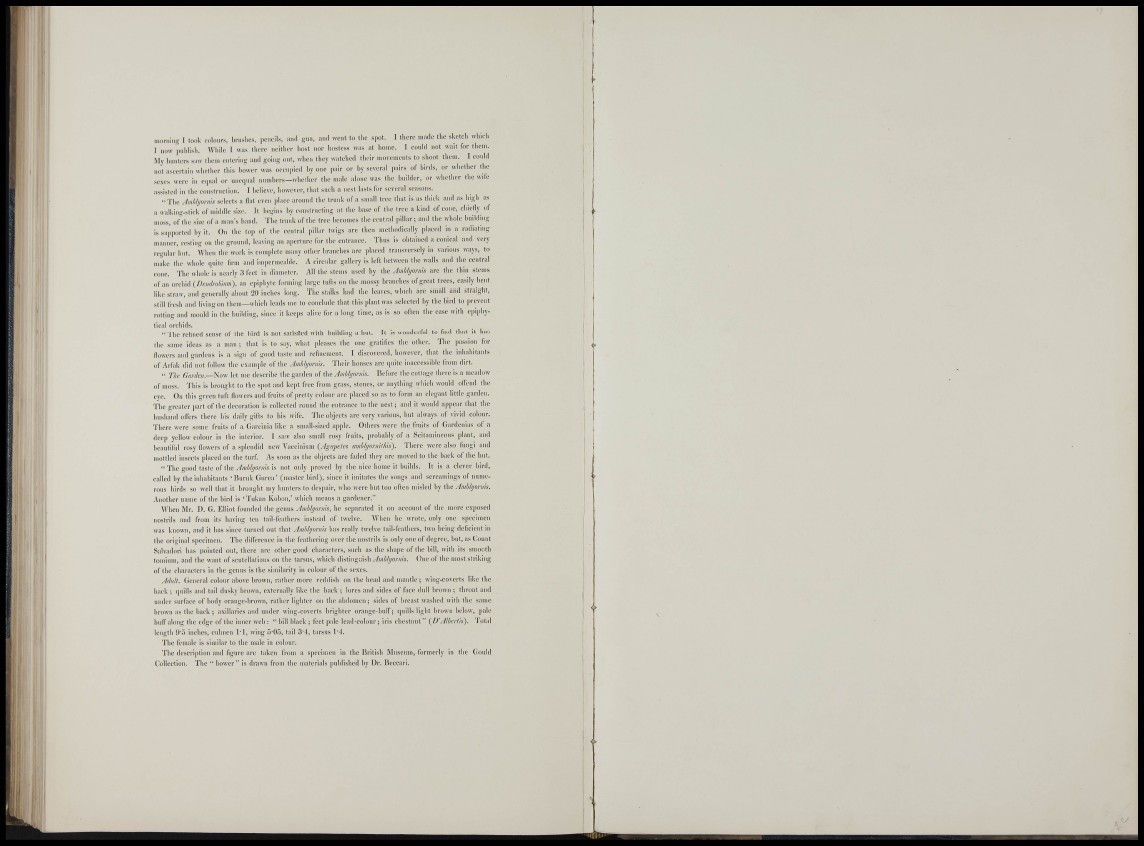
!ifl
,„on,inii I took colours, hrnslics, pciic-ils aiul su", went to the spot. I there made tlie sketeli which
1 luiw puhhsh. AVhlle 1 was there neither host nor liostess was at home. I could not wait lor them.
My hunters saw ihem cuteriiig and going out, when they watched their movements to shoot them. I conki
not ascertain whether this hower was ocenplcd hy one pair or hy several pairs of birds, or wliether the
se.\-es were lii equal or nue.inal iinmhers—whether the male alone was the builder, or whether the wife
jtcd in Ihe constrnction. I believe, Iiowever, that snch a nest lasts for several seasons.
••I'lie AmUiioriih selects a flat even place around the trunk of a small tree that is as thick and as high as
a walking-stick of middle si/.e. It begins by constructing at the base of the tree a kind of cone, chiefly of
moss, of Ihe si/.e of a man's hand. The trnnk of the tree becomes the central pillar ; and the whole buildhig
is supported by it. On the top of the central pillar twigs are then methodically placed in a radiating
niauner, resting on the ground, leaving an aperture for the entrance. Thus is obtained a conical and very
regular lint. When the work is complete many other branches arc placcd transversely in various ways, to
make the whole quite firm and iinpeinieable. A circular gallery is left between the walls and the central
cone. The whole is nearly .'5 feet in diameter. All the stems used by the Ambhjorms are the thin stems
of an orchid {^I>cii(lrMmi), an epiphyte forming large tufts on the mossy branches of great trees, easily bent
like straw, and generally about 20 inches long. The stalks had the leaves, which are small and straight,
still fresh ami living on them—which leads me to conclude that this plant was selected by the bird to prevent
rotting and monld in the building, since it kecjis alive for a long time, as is so often Ihe case with e|)i|ihytical
orchids.
" The refined sense of the bird is not satisfied with building a hut. It is wonderful to find that it has
Ihe same ideas as a man ; that is to say, what pleases the one gratifies the other. The passion for
flowers and gardens is a sign of good taste and refinement. I discovered, however, that Ihe inhabitants
of Arlak did not follow the e.vample of the Amhhjonm. Their houses are ipiite inaccessible from dirt.
" The ftm/CT.—Now let me describe the garden of the Ambhjorms. Before the cottage there is a meadow
of moss. This is brought to the spot mid kept free from grass, stones, or anything which would olfend the
eye. On this green tuft llowers and fruits of jiretty colour are placed so as to form an elegant little garden.
The greater part of the decoration is collected round the entrance to the nest; and it would appear that the
hnsbimd olfers there his daily gifts to his wife. The objccts arc very various, but always of vivid colour.
There were some fruits of a Garcinia like a small-sized apple. Gibers were the fruits of Gardenias of a
deep yellow colour in the interior. I saw also small rosy fruits, probably of a Seitaniiiieous jilant, and
beantiful rosy llowers of a s|)lendid new Vacciniiim {Agapetes amblnormllils). There were also fungi and
moltled insects placed on the turf. As soon as the objects are faded they are moved to the back of the hut.
" T h e good tasle of the Ambhjorms is not only proved by the nice home it bnilds. It is a clever bird,
called by the inhabitants ' Burnk Gnrea' (master bird), since it imitates the songs and screamings of numerous
birds so well that it brought my hunters to dcsjiair, who were bnt too often misled by the Ambhjorms.
Another name of the bird is 'Tnkan Kobon,' which means a gardener."
^^'hen Mr. D. G. Elliot founded the genus Ambhjorms, he separated it on account of the more exposed
nostrils and from its having ten tail-feathers instead of twelve. When he wrote, only one specimen
was known, and it has since turned out that Ambhjornis has really twelve tail-feathers, two being deficient in
the original specimen. The dillereiicc iii the feathering over the nostrils is only one of degree, hut, as Count
Salvadori has pointed out, there are other good characters, such as the shape of the bill, with its smooth
tominm, and the want of scutellations on the tarsus, which distinguish Ambhjornis. One of the most striking
of the characters in the genus is the similarity in colour of the sex'es.
Adult. General colour above brown, rather more reddish on the head and mantle; wiiig-coverts like the
hack ; cpiills and tail dusky brown, externally like the back ; lores and sides of face dull brown ; throat and
under surfacc of body orange-brown, rather lighter on the abdomen ; sides of breast washed with the same
brown as the back ; axillaries and under wing-coverts brighter orangc-bu(T; qnills light brown below, pale
bnlf along the edge of the inner web : " bill black ; feet pale lead-colour ; iris chestnut " {D'Albertis'). Total
length !)'.') inches, culmen I'l, wing 5 05, tail 3-4, tarsus 1-4.
The female is similar to the male in colour.
The description and figure arc taken from a specimen in the British Museum, formerly in the Gould
Collection. The " bower" is drawn from the materials iiuhlished by Dr. Beecari.
i f
•1',
li